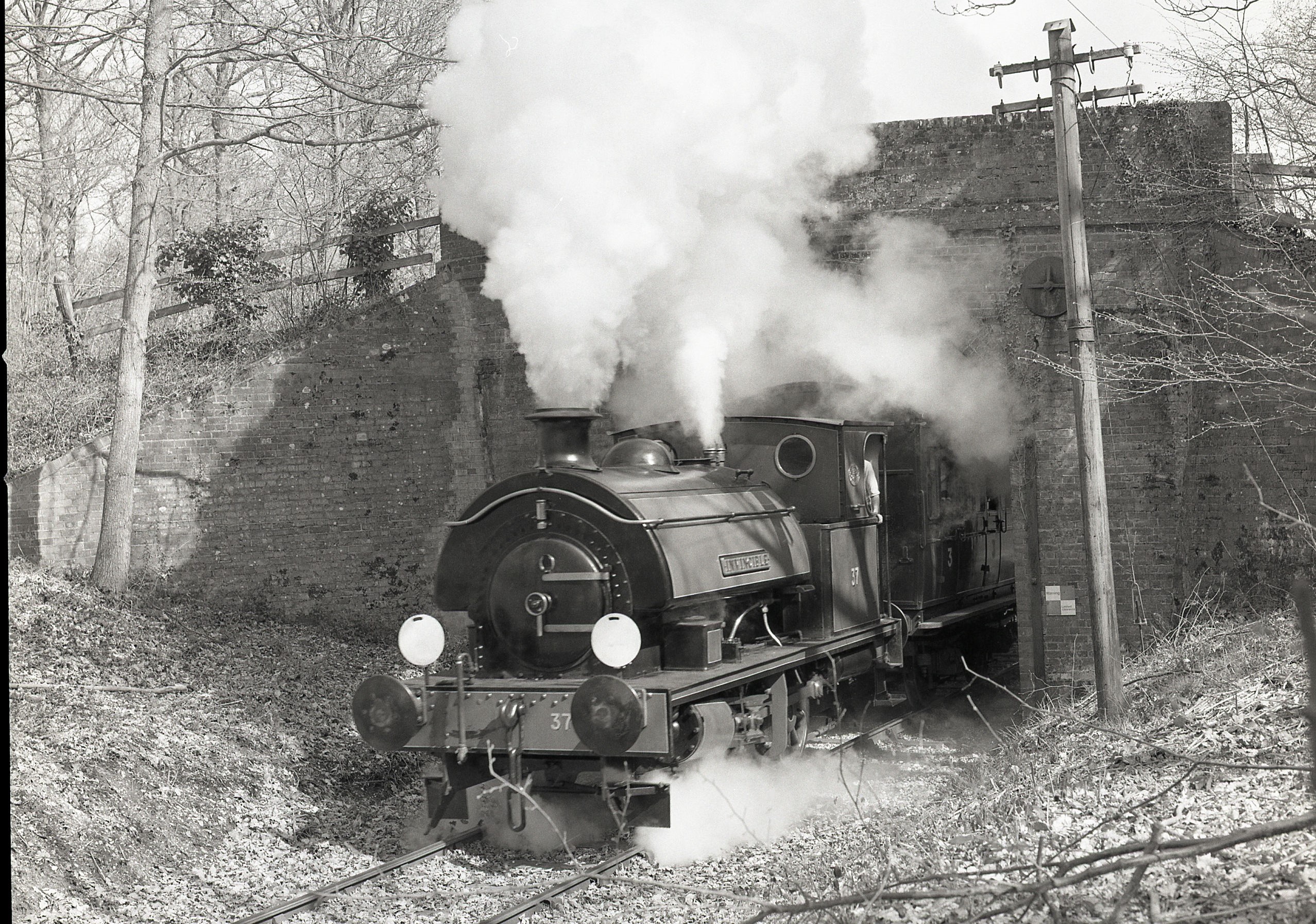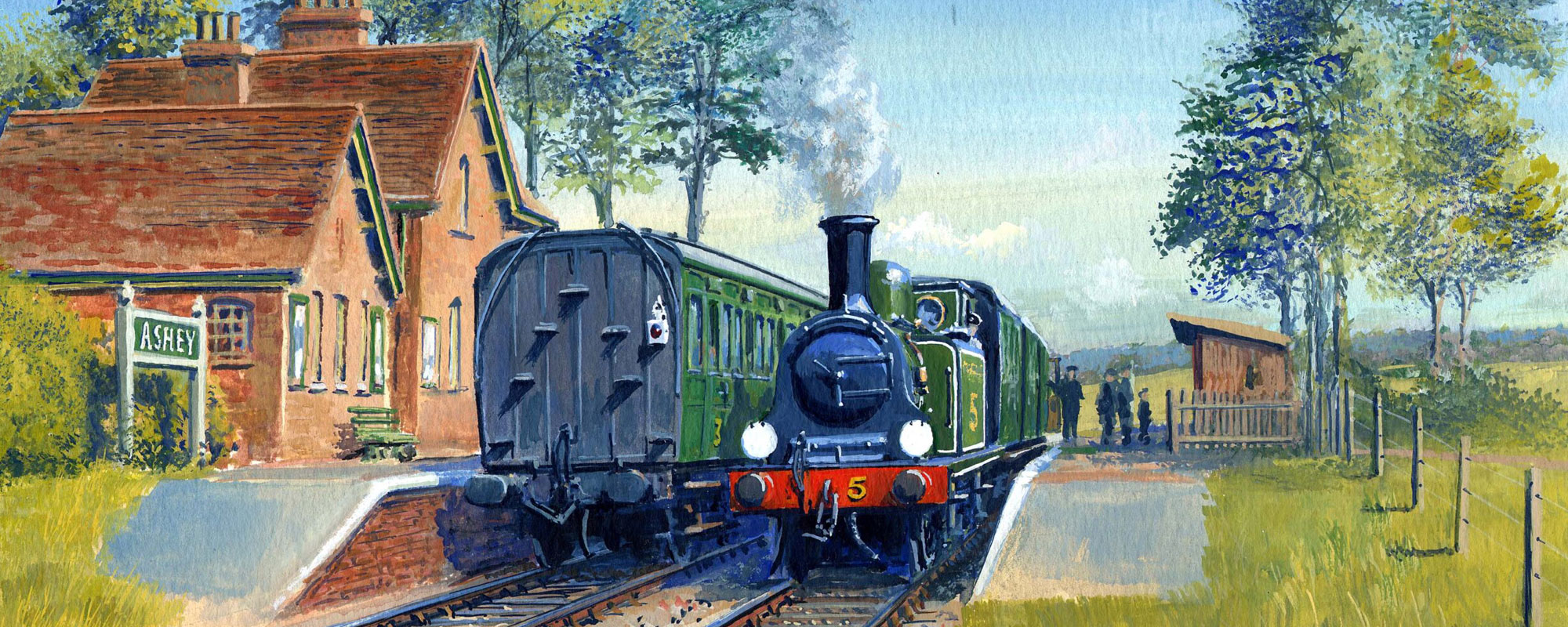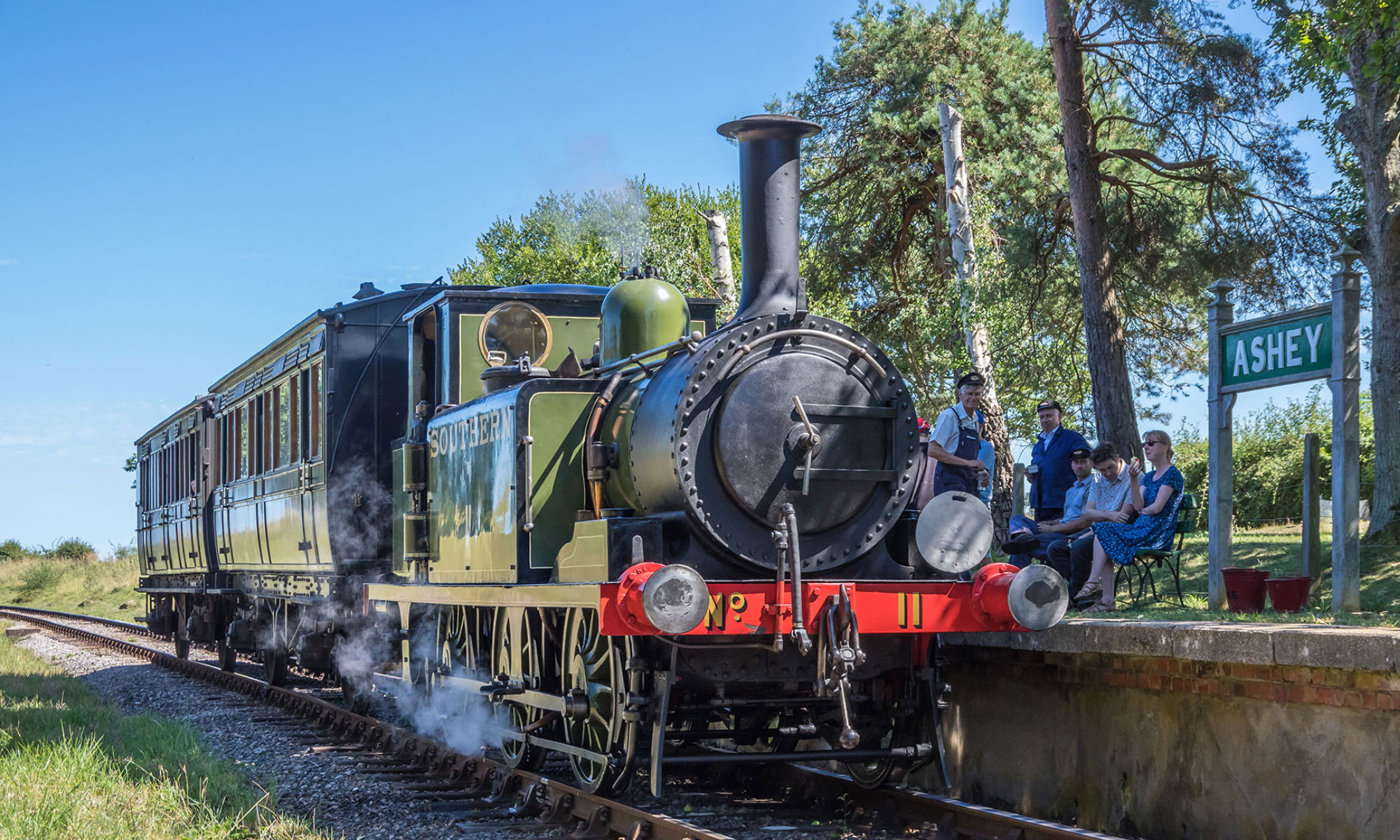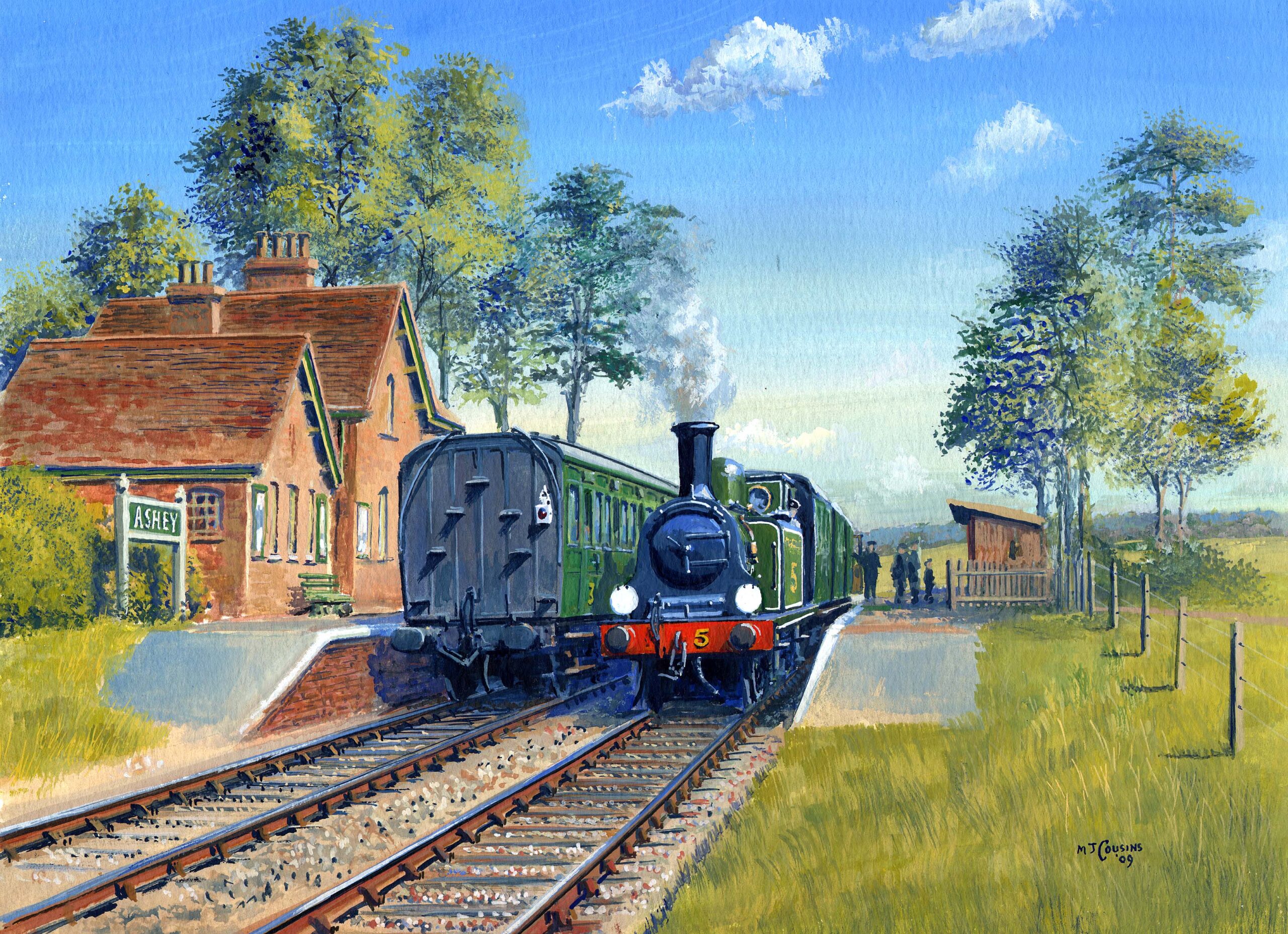History & Background
Bridge 12 is situated about 0.4 miles west of Havenstreet station and was constructed in circa 1875 by contractors building the Ryde & Newport Railway. The bridge was built as an accommodation crossing to allow the landowner the cross the line. The land either side of the railway is now in separate ownership and the railway has no obligation to maintain a link.
Until the extension to Smallbrook, Bridge 12 was the only bridge crossing the line. It therefore has historical significance both to the line and the IWSR.
As is well known, significant sections of our railway are constructed on clay subsoil which is subject to ground movement during extremely dry or wet weather conditions. Bridge 12 sits on this clay and has suffered as a result of ground movement for many years.

W37 Invincible passes through Bridge 12 during the 1970s.
Over the last 35 years the structure has required considerable time and money in maintenance, and in 1990 the Wootton section had to be closed to traffic to enable urgent repairs.
- 1978: Construction of a new wing wall
- 1990/91: Extensive rebuilding using steel ‘staples’ to retain the bricks, and a concrete saddle over the arch.
- 1996: Addition of hoops under the arch.
- 2000: Rebuilt parapets and brickwork repairs.
- 2002 and 2019: Galvanised mesh added to prevent falling brick fragments
- 2015: Tie bars installed on the north abutment
- 2019: Brick parapets removed and replaced with metal railings
- 2020: The pilasters were removed after one fell to the ground.
 Rebuilding underway in 1990/91
Rebuilding underway in 1990/91
Current Position
The matter was brought before the Board in February 2022 with an initial assessment of the condition of the bridge and early indications of the options ranging from monitoring, through repair to rebuilding and removal.
The initial professional advice was that the bridge could not be left to deteriorate further, and that the options for temporary repairs through to rebuilding would all involve very significant cost, with a further risk of escalating cost throughout any works. The recommendation to the Board was to remove the bridge.
The Board discussed the situation at length and in detail, recognising the historical significance of the bridge. The decision was made to seek more information on which to make a decision. While the bridge has significance, we are able to record every aspect of it both for interpretation purposes, and to maintain a record of the bridge for use in the future.
The dry Summer in 2022 caused further movement, raising a significant concern in relation to the potential for a structural failure.
A report was sought from Andy Merritt, who was Director with responsibility for Heritage & Learning at the time, on the heritage implications and considerations, and in Autumn 2022 we spent £7,000 on trial pits and borehole investigations to understand in more detail the stability of the foundations and to investigate if it would be possible to stabilise the bridge.
Our Infrastructure Manager is a Professional Civil /Structural Engineer with extensive experience of bridge structures, who has commissioned and overseen the investigations and subsequent options and recommendations. In addition he has engaged further specialist professional advice from consultants Graham Cole and Prof Matthew Gilbert.
The bridge continues to suffer from movement and on 9 September 2023 the Board considered all the reports placed before it, with a need to make a decision so that work could be scheduled.

Options
The Board was presented with five potential options. Broadly, the options were as follows:
Doing nothing or minimal maintenance was not considered to be a viable option.
Repairs: Installing concrete beams under the track to support the walls, then digging out the infill and adding a concrete saddle tied into the brick arch. This would only be a part solution, leaving the wing walls at risk of further movement. In addition, there would be a considerable risk of the arch failing during the works. The indicative cost of this work, without contingency, would be around £100,000. These works may extend the life of the bridge, but would only delay more substantial works. IW Council carried out a total reconstruction of a similar overbridge at Fattingpark Farm to the west of Wootton at substantial cost some years ago and the new structure continues to require repair and maintenance because of clay heave.
Replacement: Early in the investigations, an indicative price was sought for full rebuilding of the bridge – the only option that would provide a long-term solution. This would require the removal of the current structure in full, including the existing ‘below ground’ structure and a complete new build. The indicative price was £350,000 plus contingency.
Replacement with a footbridge: This would have been cheaper than a full rebuild, but offered no real advantage.
Removal of the bridge. With the land on both sides of the line now in different ownership, the bridge no longer serves any access purpose and there is no legal obligation to provide access across it. For the last two years it has been fenced off to prevent pedestrian access to the structure. Removal can be undertaken in house, within the closed season, and has the advantage that the level of the trackbed can be raised slightly to alleviate water saturation through the section.
The Board accepted that a decision needed to be taken to prevent further deterioration and potential failure of the bridge.
Reluctantly the decision was made to record in full detail the current bridge and subsequently remove the current structure. This does not preclude a future reconstruction of the bridge as this option in any case required the removal of the full current structure.
The Board did not believe that it would be prudent at this time to either invest a considerable sum in a temporary fix, or a very significant sum in a complete rebuild.
The dormouse crossing that sits above the structure of the bridge will be retained but it may be necessary to temporarily remove it during dismantling works.

Peter Taylor, Chairman
“Over the last two years, the board has carefully considered all options and sought professional advice. It was clear that none of the proposed repairs would act a permanent solution, and that the bridge would continue to require significant ongoing investment.”
“The history and heritage aspects of Bridge 12 were very much in directors minds when evaluating the way forward. As one of the line’s original structures, there was naturally a hope that this aspect of the line’s heritage could be preserved. Nevertheless we recognise that the bridge is in poor condition and has been subject to many repairs over the years which have reduced how much of the bridge is original and altered its appearance. As trustees we felt that there were better uses of the charity’s funds, and that dismantling the bridge was ultimately in the best long-term interests of the Railway.”
“Taking the decision to dismantle part of the line’s infrastructure was not taken lightly. As directors and trustees of the railway we needed to carefully weigh up the heritage, financial and safety implications. We’re fortunate the rest of the line’s bridges are in good condition, however Bridge 12 has long been problematic and deteriorated to the point where we can’t ignore its condition. In the first instance we will ensure that Bridge 12 is properly recorded by photographing and laser-scanning the structure, to act as a permanent record”.







